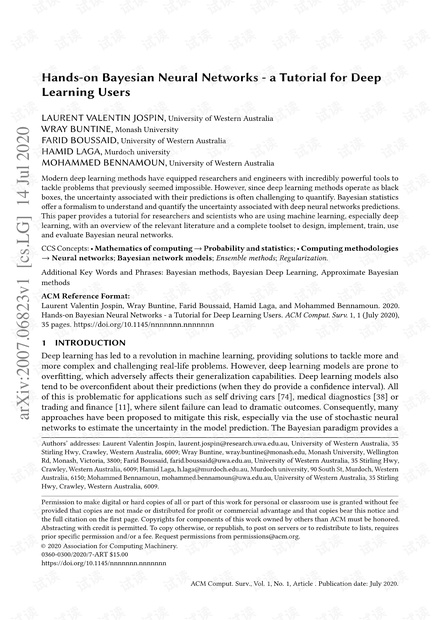ACM Computing Surveys文章:一文入门贝叶斯神经网络
贝叶斯神经网络是一种结合了贝叶斯统计方法和神经网络的机器学习技术,目的是为了解决深度学习模型中预测不确定性的量化问题。传统的深度学习模型,如卷积神经网络、循环神经网络和深度前馈网络等,虽然在处理复杂问题上取得了巨大成功,但其“黑盒”的特性使得模型的内部工作机制不透明,预测结果的不确定性难以量化。 贝叶斯统计提供了一种框架,可以通过概率分布的形式来量化不确定性。在贝叶斯神经网络中,模型参数不再被视为单一的点估计,而是参数的概率分布。这使得我们能够考虑模型在给定数据集上的所有可能的参数配置,并且能够计算预测结果的不确定度。 贝叶斯神经网络的核心思想是对神经网络的权重进行贝叶斯推断,通过对权重的概率分布进行推断来预测新样本。这种推断通常通过贝叶斯规则来完成,即后验概率分布正比于似然函数和先验概率分布的乘积。在这个过程中,先验概率分布体现了我们对参数的先验知识,而似然函数则描述了给定模型参数下观测到数据的概率。通过贝叶斯推断,我们能够得到后验分布,它结合了先验知识和观测数据,从而能够量化模型预测的不确定性。 研究贝叶斯神经网络对于理解深度学习模型的工作机制、提高模型的泛化能力以及为实际应用提供更可靠的预测非常关键。在实际应用中,比如自动驾驶汽车、医疗诊断或金融市场交易等领域,模型的可靠性和预测的不确定性具有重要的现实意义。贝叶斯神经网络能够帮助避免由于过度自信的预测而导致的潜在风险。 在贝叶斯神经网络的研究中,主要的挑战之一是如何有效地计算后验分布。由于神经网络的复杂性,直接计算通常是不可行的,因此研究者们开发了多种近似推断技术,如变分贝叶斯、马尔可夫链蒙特卡洛(MCMC)方法等,来近似后验分布。这些方法能够在保持一定计算效率的同时,提供对后验分布的合理估计。 贝叶斯神经网络的研究和应用不仅需要理解神经网络本身,还要熟悉贝叶斯统计方法、概率论以及数值计算技术。尽管这一领域相对较新,但已迅速发展成为机器学习领域的重要研究方向之一。 贝叶斯神经网络是一个集成深度学习和贝叶斯统计的强大工具,为深度学习中的不确定性量化提供了一个科学的解决方案。通过提供预测不确定性的量化,贝叶斯神经网络在提高模型的可靠性和准确性、增强其在重要领域的应用潜力方面,发挥着至关重要的作用。随着研究的不断深入和技术的不断进步,我们有理由相信贝叶斯神经网络将在未来的学习算法中扮演更加重要的角色。





剩余34页未读,继续阅读

 BJWcn2023-07-27这篇文章对贝叶斯神经网络的优缺点进行了全面的分析,具有很高的实用价值。
BJWcn2023-07-27这篇文章对贝叶斯神经网络的优缺点进行了全面的分析,具有很高的实用价值。 柔粟2023-07-27阅读完这篇文章,我对贝叶斯神经网络有了更深入的了解,感觉收获很大。
柔粟2023-07-27阅读完这篇文章,我对贝叶斯神经网络有了更深入的了解,感觉收获很大。 查理捡钢镚2023-07-27作者以简明的语言解释了贝叶斯神经网络的原理,让人容易理解。
查理捡钢镚2023-07-27作者以简明的语言解释了贝叶斯神经网络的原理,让人容易理解。 RandyRhoads2023-07-27这篇文章对贝叶斯神经网络的介绍浅显易懂,适合新手入门。
RandyRhoads2023-07-27这篇文章对贝叶斯神经网络的介绍浅显易懂,适合新手入门。 邢小鹏2023-07-27文章详细讲述了贝叶斯神经网络在ACM Computing Surveys领域的应用,有助于研究者深入了解。
邢小鹏2023-07-27文章详细讲述了贝叶斯神经网络在ACM Computing Surveys领域的应用,有助于研究者深入了解。

- 粉丝: 158
- 资源: 1179
 我的内容管理
展开
我的内容管理
展开
 我的资源
快来上传第一个资源
我的资源
快来上传第一个资源
 我的收益 登录查看自己的收益
我的收益 登录查看自己的收益 我的积分
登录查看自己的积分
我的积分
登录查看自己的积分
 我的C币
登录后查看C币余额
我的C币
登录后查看C币余额
 我的收藏
我的收藏  我的下载
我的下载  下载帮助
下载帮助

 前往需求广场,查看用户热搜
前往需求广场,查看用户热搜最新资源
- Refrig-RefrigerationBoxLoads.exe
- AHTTv510.pdf
- TRANE.zip
- 开利PLV IPLV计算软件ECAT-PLV120.zip
- Copeland-Refrigeration-Manuals.zip
- 汽车空调制冷系统匹配设计1.pdf
- 换热器选型GreenheckCoilSelection.zip
- SystemSyzerPsychrometric .exe
- 汽车空调制冷系统匹配研究1.pdf
- 混合动力汽车空调系统研究及优化1.pdf
- 电动汽车热泵空调系统匹配特性研究1.pdf
- 基于互信息(MI)的回归数据特征选择算法 matlab代码
- 纯电动汽车动力电池与空调联合热管理仿真研究1.pdf
- 某车型汽车空调系统匹配研究1.pdf
- 汽车空调制冷系统匹配计算及研究1.pdf
- 商用车驻车空调系统性能分与实验研究1.pdf


 信息提交成功
信息提交成功